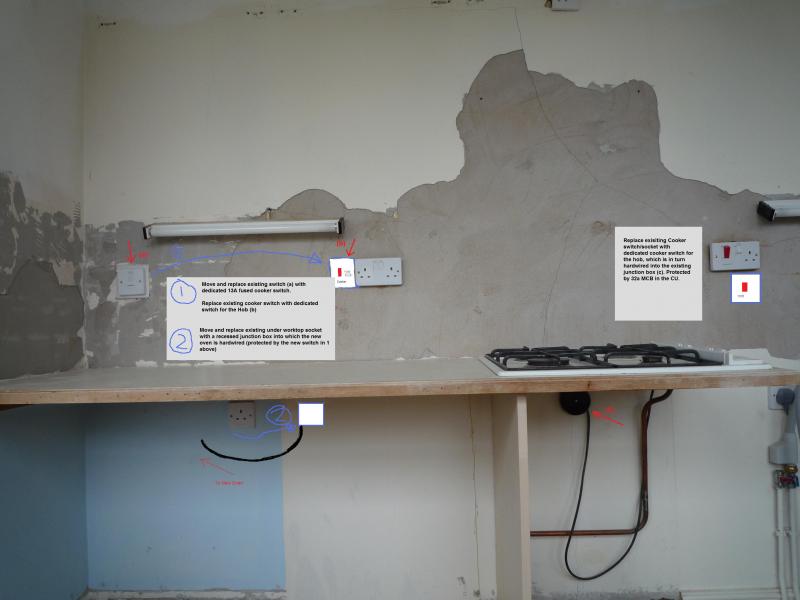Hi, first post, although have used the site from time to time for good advice so go easy on me!
I'm refitting a kitchen that was fitted around 10-15 yrs ago. My consumer unit is a Crabtree box (with RCD) and the cooker circuit is on a 32 Amp MCB at the unit.
This then leads to a Switched cooker and single socket unit on the wall, which in turn leads to a surface mounted junction box.
The old gas hob (electric ignition) and single electric oven used to both connect to this junction box.
I believe the cable is 6mm
So onto my queries:
I plan to fit a Siemens single oven rated at 3300w and a Siemens Induction hob rated at 7200w(!). Both the oven and hob have to be hardwired.
7200/230 = 31.3 Amps
3300/230 = 14.35 Amps
1st option:
I'm not sure I can connect both of these to the junction box without any changes. If I were to do so and change the cooker switch/socket unit for just a cooker switch and swap out the 32a MCB for a 45a MCB would this be ok?
2nd option:
Connect the Hob to the existing junction box with the existing 32a MCB protection in place, change the cooker switch/socket unit to just a cooker switch.
There is an existing switched 13amp supply which was used to power a fridge freezer (fused switch above worktop, unswitched socket below) Can I replace this socket with a junction box to connect the new oven to and change the switch unit for a more obvious dedicated (red) oven switch.
I will add a photo of the existing setup if it helps to explain. Apologies for the vague terminology in parts!
I'm refitting a kitchen that was fitted around 10-15 yrs ago. My consumer unit is a Crabtree box (with RCD) and the cooker circuit is on a 32 Amp MCB at the unit.
This then leads to a Switched cooker and single socket unit on the wall, which in turn leads to a surface mounted junction box.
The old gas hob (electric ignition) and single electric oven used to both connect to this junction box.
I believe the cable is 6mm
So onto my queries:
I plan to fit a Siemens single oven rated at 3300w and a Siemens Induction hob rated at 7200w(!). Both the oven and hob have to be hardwired.
7200/230 = 31.3 Amps
3300/230 = 14.35 Amps
1st option:
I'm not sure I can connect both of these to the junction box without any changes. If I were to do so and change the cooker switch/socket unit for just a cooker switch and swap out the 32a MCB for a 45a MCB would this be ok?
2nd option:
Connect the Hob to the existing junction box with the existing 32a MCB protection in place, change the cooker switch/socket unit to just a cooker switch.
There is an existing switched 13amp supply which was used to power a fridge freezer (fused switch above worktop, unswitched socket below) Can I replace this socket with a junction box to connect the new oven to and change the switch unit for a more obvious dedicated (red) oven switch.
I will add a photo of the existing setup if it helps to explain. Apologies for the vague terminology in parts!
Existing socket/switch layout
- JimboJet
- 1
Proposed changes to allow new electric oven and induction hob


